Business Model Analysis and Strategic Frameworks
VerifiedAdded on 2021/04/24
|17
|3923
|68
AI Summary
The assignment requires a detailed analysis of business models, including their relationship with marketing, as well as an examination of strategic frameworks such as Porter's Five Forces and PESTLE analysis. It also involves a review of various studies and articles on the topic, providing a comprehensive understanding of the subject matter.
Contribute Materials
Your contribution can guide someone’s learning journey. Share your
documents today.
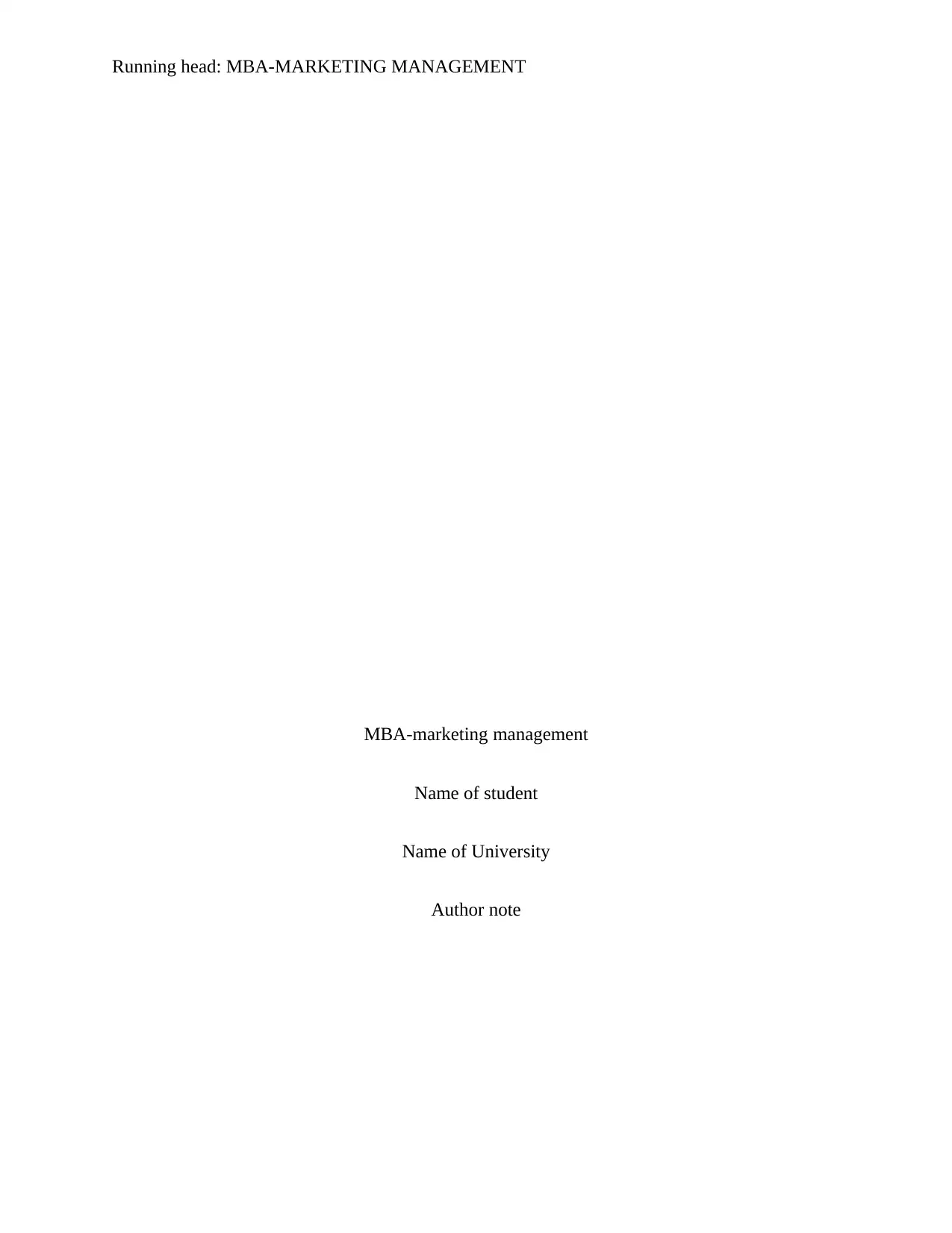
Running head: MBA-MARKETING MANAGEMENT
MBA-marketing management
Name of student
Name of University
Author note
MBA-marketing management
Name of student
Name of University
Author note
Secure Best Marks with AI Grader
Need help grading? Try our AI Grader for instant feedback on your assignments.
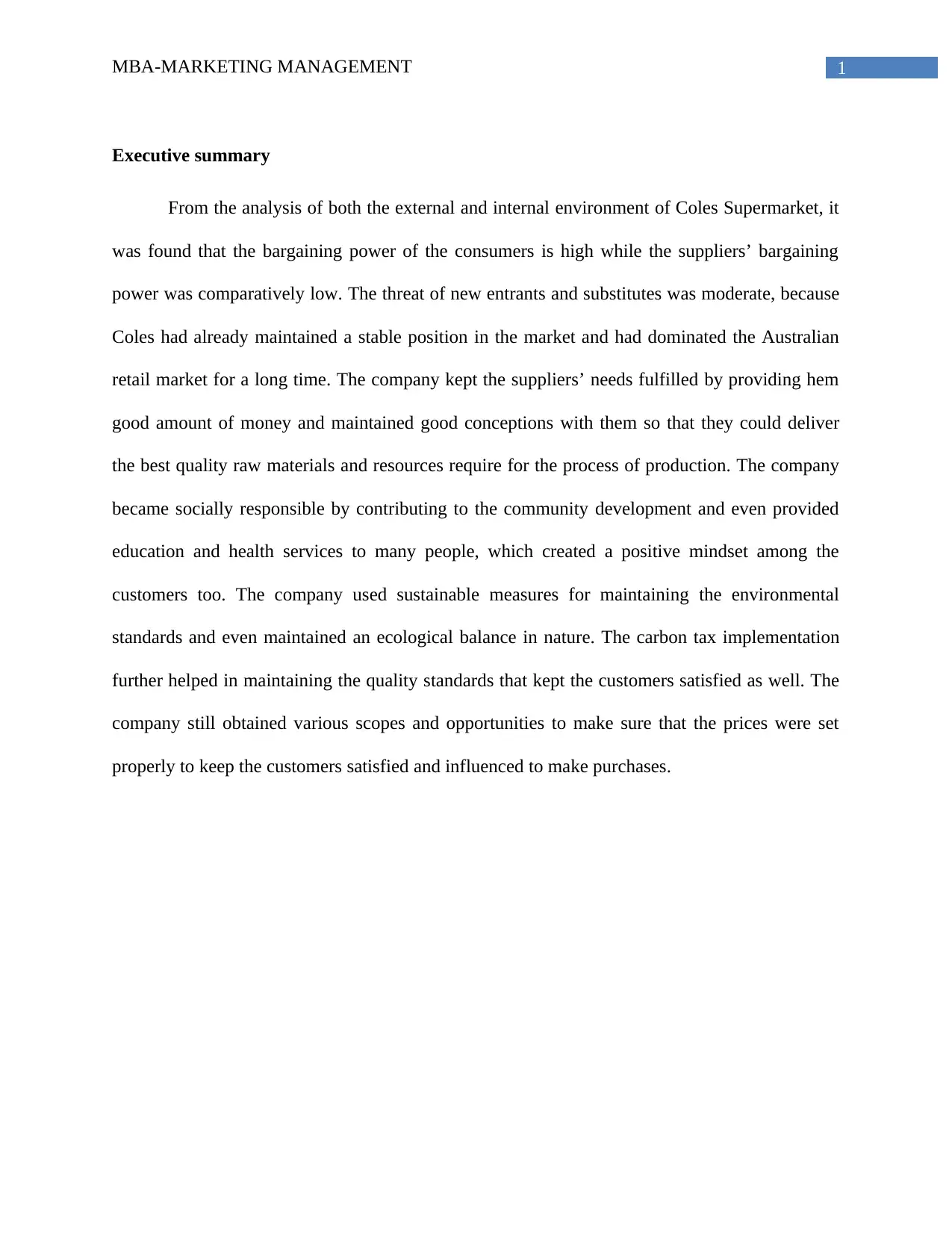
1MBA-MARKETING MANAGEMENT
Executive summary
From the analysis of both the external and internal environment of Coles Supermarket, it
was found that the bargaining power of the consumers is high while the suppliers’ bargaining
power was comparatively low. The threat of new entrants and substitutes was moderate, because
Coles had already maintained a stable position in the market and had dominated the Australian
retail market for a long time. The company kept the suppliers’ needs fulfilled by providing hem
good amount of money and maintained good conceptions with them so that they could deliver
the best quality raw materials and resources require for the process of production. The company
became socially responsible by contributing to the community development and even provided
education and health services to many people, which created a positive mindset among the
customers too. The company used sustainable measures for maintaining the environmental
standards and even maintained an ecological balance in nature. The carbon tax implementation
further helped in maintaining the quality standards that kept the customers satisfied as well. The
company still obtained various scopes and opportunities to make sure that the prices were set
properly to keep the customers satisfied and influenced to make purchases.
Executive summary
From the analysis of both the external and internal environment of Coles Supermarket, it
was found that the bargaining power of the consumers is high while the suppliers’ bargaining
power was comparatively low. The threat of new entrants and substitutes was moderate, because
Coles had already maintained a stable position in the market and had dominated the Australian
retail market for a long time. The company kept the suppliers’ needs fulfilled by providing hem
good amount of money and maintained good conceptions with them so that they could deliver
the best quality raw materials and resources require for the process of production. The company
became socially responsible by contributing to the community development and even provided
education and health services to many people, which created a positive mindset among the
customers too. The company used sustainable measures for maintaining the environmental
standards and even maintained an ecological balance in nature. The carbon tax implementation
further helped in maintaining the quality standards that kept the customers satisfied as well. The
company still obtained various scopes and opportunities to make sure that the prices were set
properly to keep the customers satisfied and influenced to make purchases.
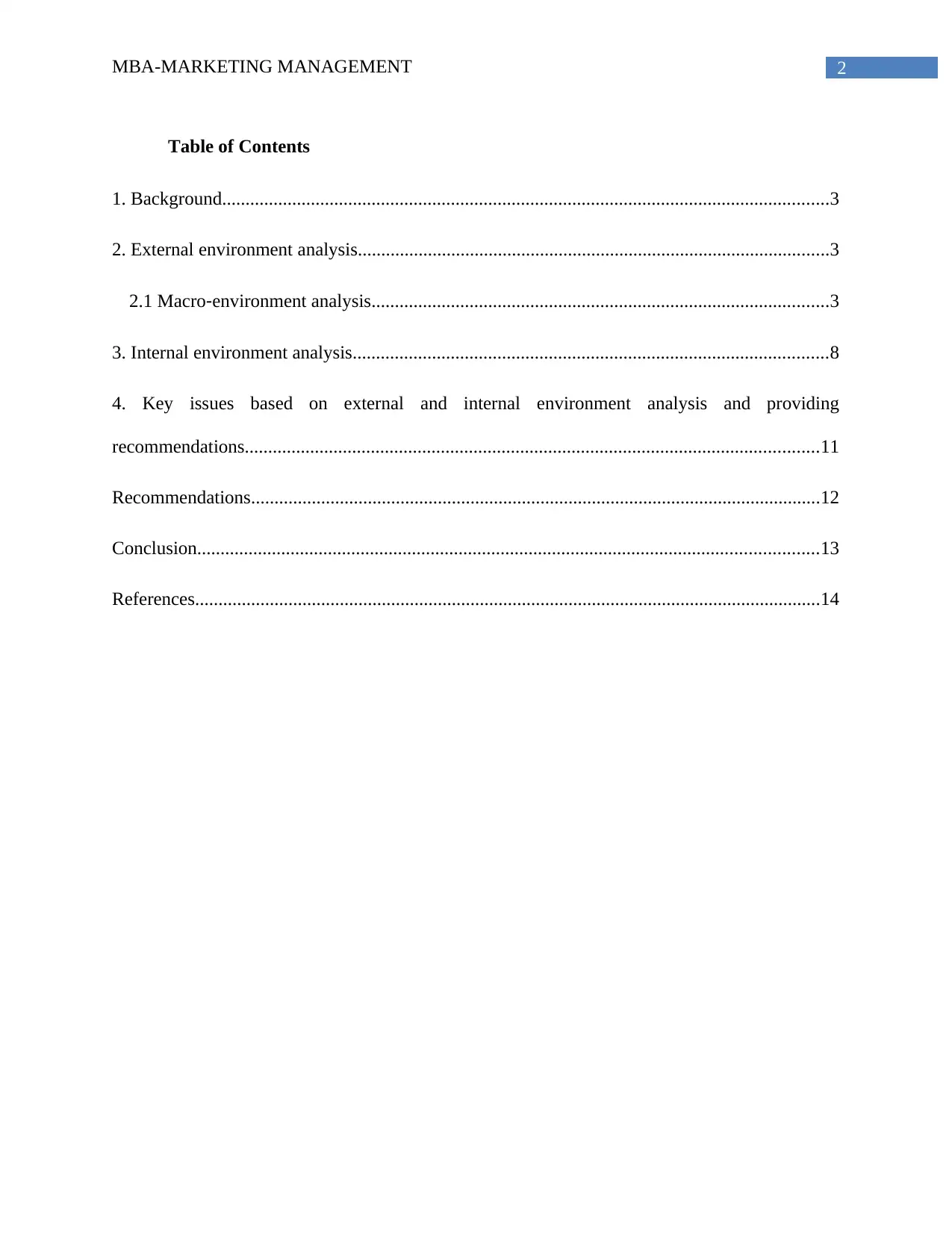
2MBA-MARKETING MANAGEMENT
Table of Contents
1. Background..................................................................................................................................3
2. External environment analysis.....................................................................................................3
2.1 Macro‐environment analysis..................................................................................................3
3. Internal environment analysis......................................................................................................8
4. Key issues based on external and internal environment analysis and providing
recommendations...........................................................................................................................11
Recommendations..........................................................................................................................12
Conclusion.....................................................................................................................................13
References......................................................................................................................................14
Table of Contents
1. Background..................................................................................................................................3
2. External environment analysis.....................................................................................................3
2.1 Macro‐environment analysis..................................................................................................3
3. Internal environment analysis......................................................................................................8
4. Key issues based on external and internal environment analysis and providing
recommendations...........................................................................................................................11
Recommendations..........................................................................................................................12
Conclusion.....................................................................................................................................13
References......................................................................................................................................14
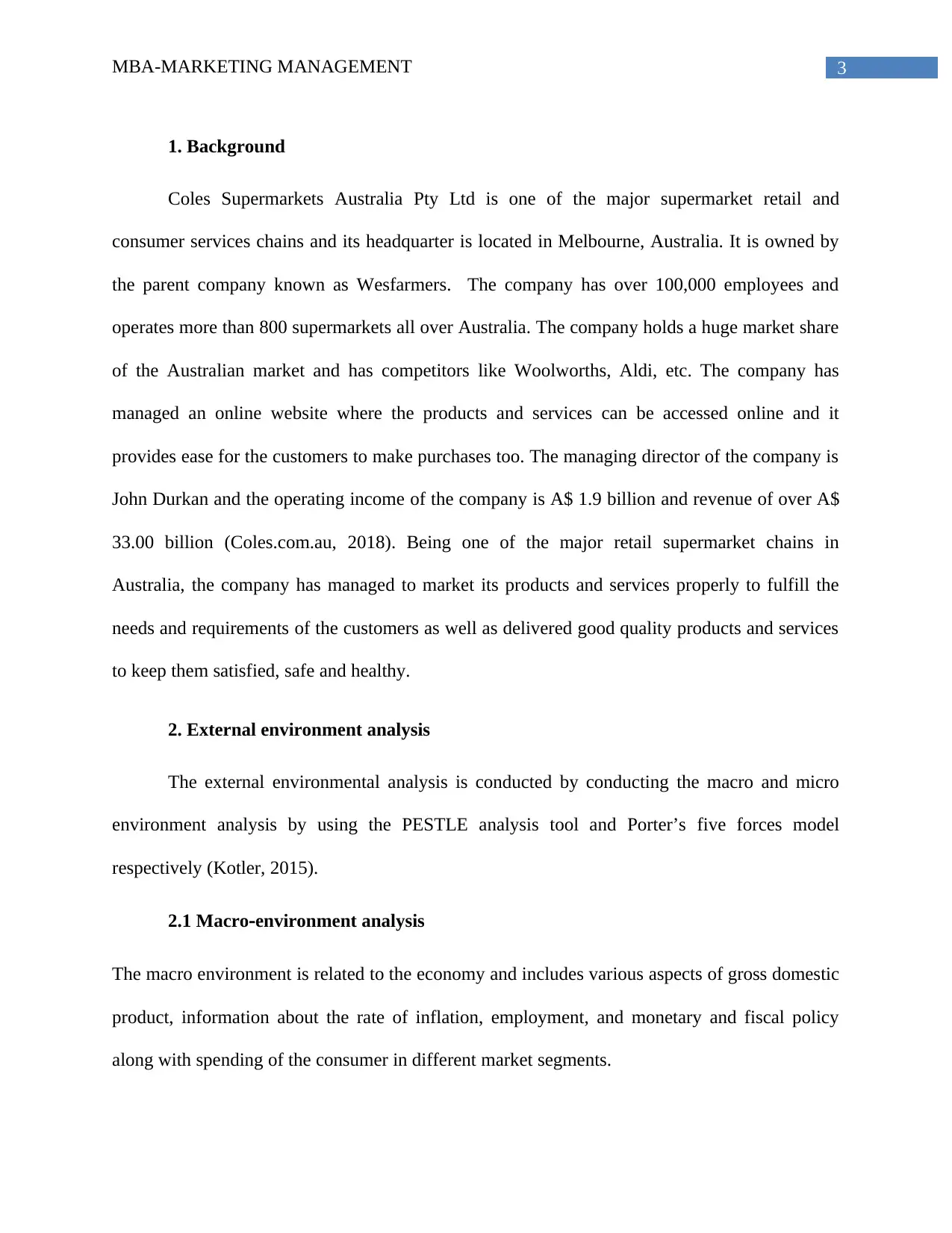
3MBA-MARKETING MANAGEMENT
1. Background
Coles Supermarkets Australia Pty Ltd is one of the major supermarket retail and
consumer services chains and its headquarter is located in Melbourne, Australia. It is owned by
the parent company known as Wesfarmers. The company has over 100,000 employees and
operates more than 800 supermarkets all over Australia. The company holds a huge market share
of the Australian market and has competitors like Woolworths, Aldi, etc. The company has
managed an online website where the products and services can be accessed online and it
provides ease for the customers to make purchases too. The managing director of the company is
John Durkan and the operating income of the company is A$ 1.9 billion and revenue of over A$
33.00 billion (Coles.com.au, 2018). Being one of the major retail supermarket chains in
Australia, the company has managed to market its products and services properly to fulfill the
needs and requirements of the customers as well as delivered good quality products and services
to keep them satisfied, safe and healthy.
2. External environment analysis
The external environmental analysis is conducted by conducting the macro and micro
environment analysis by using the PESTLE analysis tool and Porter’s five forces model
respectively (Kotler, 2015).
2.1 Macro‐environment analysis
The macro environment is related to the economy and includes various aspects of gross domestic
product, information about the rate of inflation, employment, and monetary and fiscal policy
along with spending of the consumer in different market segments.
1. Background
Coles Supermarkets Australia Pty Ltd is one of the major supermarket retail and
consumer services chains and its headquarter is located in Melbourne, Australia. It is owned by
the parent company known as Wesfarmers. The company has over 100,000 employees and
operates more than 800 supermarkets all over Australia. The company holds a huge market share
of the Australian market and has competitors like Woolworths, Aldi, etc. The company has
managed an online website where the products and services can be accessed online and it
provides ease for the customers to make purchases too. The managing director of the company is
John Durkan and the operating income of the company is A$ 1.9 billion and revenue of over A$
33.00 billion (Coles.com.au, 2018). Being one of the major retail supermarket chains in
Australia, the company has managed to market its products and services properly to fulfill the
needs and requirements of the customers as well as delivered good quality products and services
to keep them satisfied, safe and healthy.
2. External environment analysis
The external environmental analysis is conducted by conducting the macro and micro
environment analysis by using the PESTLE analysis tool and Porter’s five forces model
respectively (Kotler, 2015).
2.1 Macro‐environment analysis
The macro environment is related to the economy and includes various aspects of gross domestic
product, information about the rate of inflation, employment, and monetary and fiscal policy
along with spending of the consumer in different market segments.
Secure Best Marks with AI Grader
Need help grading? Try our AI Grader for instant feedback on your assignments.
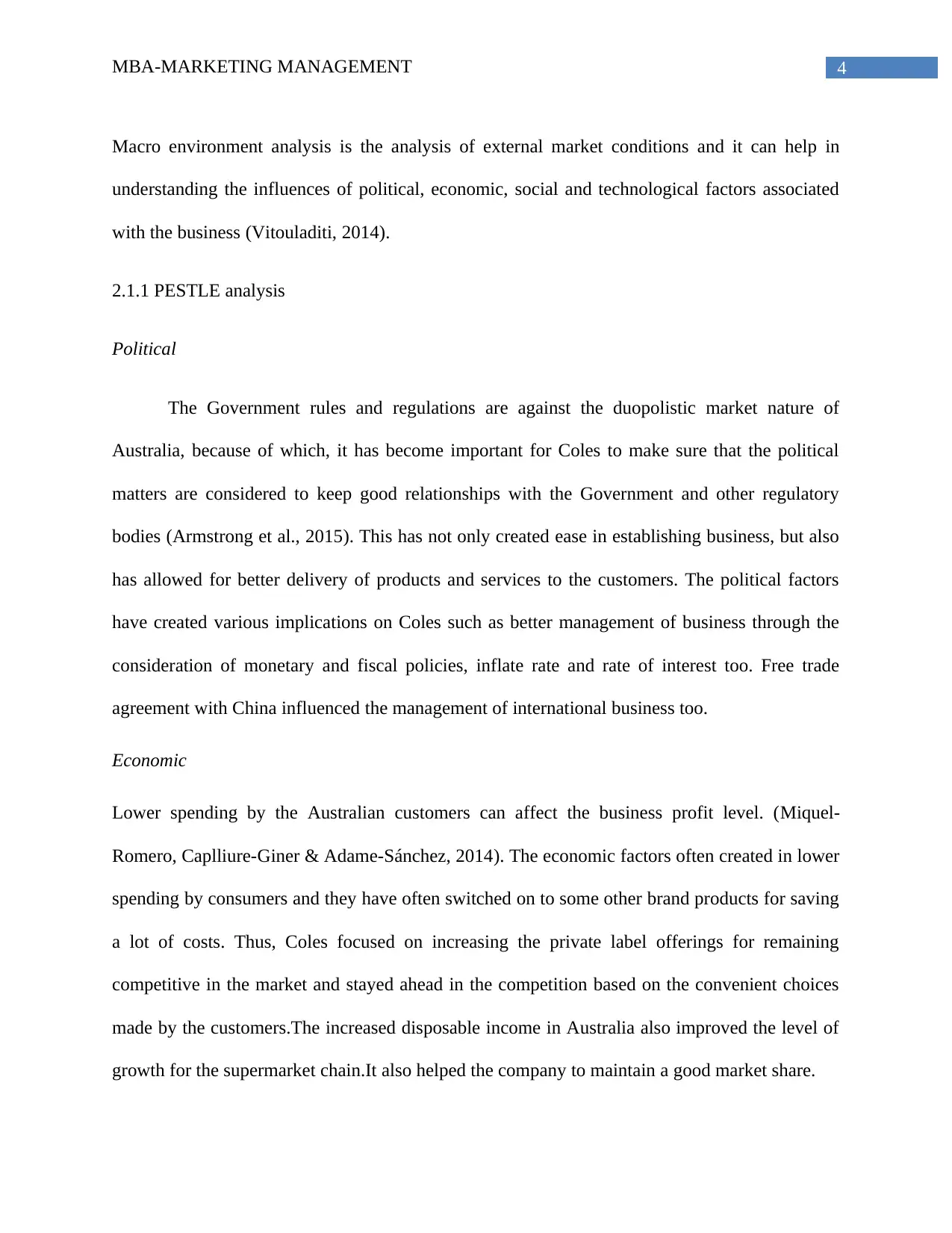
4MBA-MARKETING MANAGEMENT
Macro environment analysis is the analysis of external market conditions and it can help in
understanding the influences of political, economic, social and technological factors associated
with the business (Vitouladiti, 2014).
2.1.1 PESTLE analysis
Political
The Government rules and regulations are against the duopolistic market nature of
Australia, because of which, it has become important for Coles to make sure that the political
matters are considered to keep good relationships with the Government and other regulatory
bodies (Armstrong et al., 2015). This has not only created ease in establishing business, but also
has allowed for better delivery of products and services to the customers. The political factors
have created various implications on Coles such as better management of business through the
consideration of monetary and fiscal policies, inflate rate and rate of interest too. Free trade
agreement with China influenced the management of international business too.
Economic
Lower spending by the Australian customers can affect the business profit level. (Miquel-
Romero, Caplliure-Giner & Adame-Sánchez, 2014). The economic factors often created in lower
spending by consumers and they have often switched on to some other brand products for saving
a lot of costs. Thus, Coles focused on increasing the private label offerings for remaining
competitive in the market and stayed ahead in the competition based on the convenient choices
made by the customers.The increased disposable income in Australia also improved the level of
growth for the supermarket chain.It also helped the company to maintain a good market share.
Macro environment analysis is the analysis of external market conditions and it can help in
understanding the influences of political, economic, social and technological factors associated
with the business (Vitouladiti, 2014).
2.1.1 PESTLE analysis
Political
The Government rules and regulations are against the duopolistic market nature of
Australia, because of which, it has become important for Coles to make sure that the political
matters are considered to keep good relationships with the Government and other regulatory
bodies (Armstrong et al., 2015). This has not only created ease in establishing business, but also
has allowed for better delivery of products and services to the customers. The political factors
have created various implications on Coles such as better management of business through the
consideration of monetary and fiscal policies, inflate rate and rate of interest too. Free trade
agreement with China influenced the management of international business too.
Economic
Lower spending by the Australian customers can affect the business profit level. (Miquel-
Romero, Caplliure-Giner & Adame-Sánchez, 2014). The economic factors often created in lower
spending by consumers and they have often switched on to some other brand products for saving
a lot of costs. Thus, Coles focused on increasing the private label offerings for remaining
competitive in the market and stayed ahead in the competition based on the convenient choices
made by the customers.The increased disposable income in Australia also improved the level of
growth for the supermarket chain.It also helped the company to maintain a good market share.
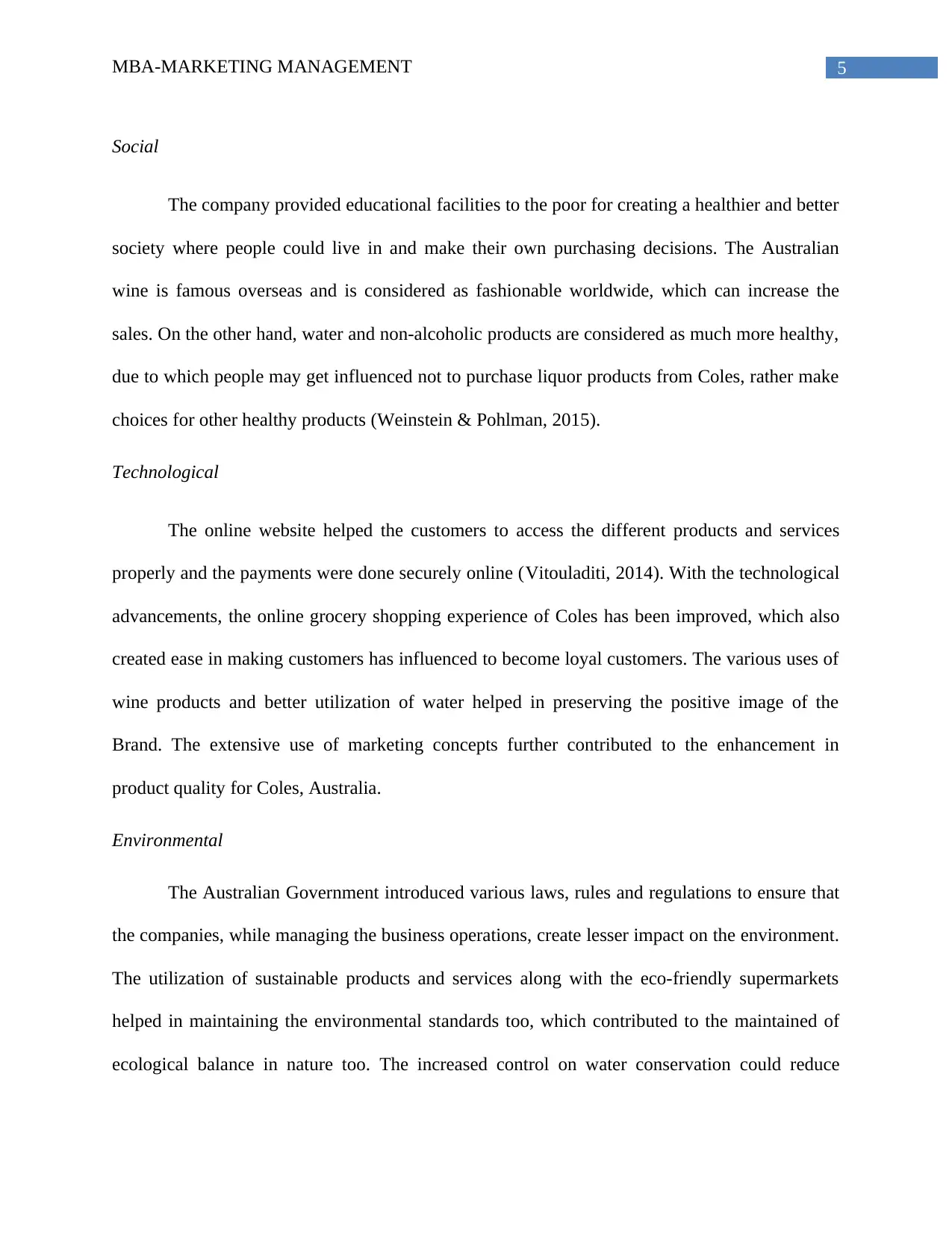
5MBA-MARKETING MANAGEMENT
Social
The company provided educational facilities to the poor for creating a healthier and better
society where people could live in and make their own purchasing decisions. The Australian
wine is famous overseas and is considered as fashionable worldwide, which can increase the
sales. On the other hand, water and non-alcoholic products are considered as much more healthy,
due to which people may get influenced not to purchase liquor products from Coles, rather make
choices for other healthy products (Weinstein & Pohlman, 2015).
Technological
The online website helped the customers to access the different products and services
properly and the payments were done securely online (Vitouladiti, 2014). With the technological
advancements, the online grocery shopping experience of Coles has been improved, which also
created ease in making customers has influenced to become loyal customers. The various uses of
wine products and better utilization of water helped in preserving the positive image of the
Brand. The extensive use of marketing concepts further contributed to the enhancement in
product quality for Coles, Australia.
Environmental
The Australian Government introduced various laws, rules and regulations to ensure that
the companies, while managing the business operations, create lesser impact on the environment.
The utilization of sustainable products and services along with the eco-friendly supermarkets
helped in maintaining the environmental standards too, which contributed to the maintained of
ecological balance in nature too. The increased control on water conservation could reduce
Social
The company provided educational facilities to the poor for creating a healthier and better
society where people could live in and make their own purchasing decisions. The Australian
wine is famous overseas and is considered as fashionable worldwide, which can increase the
sales. On the other hand, water and non-alcoholic products are considered as much more healthy,
due to which people may get influenced not to purchase liquor products from Coles, rather make
choices for other healthy products (Weinstein & Pohlman, 2015).
Technological
The online website helped the customers to access the different products and services
properly and the payments were done securely online (Vitouladiti, 2014). With the technological
advancements, the online grocery shopping experience of Coles has been improved, which also
created ease in making customers has influenced to become loyal customers. The various uses of
wine products and better utilization of water helped in preserving the positive image of the
Brand. The extensive use of marketing concepts further contributed to the enhancement in
product quality for Coles, Australia.
Environmental
The Australian Government introduced various laws, rules and regulations to ensure that
the companies, while managing the business operations, create lesser impact on the environment.
The utilization of sustainable products and services along with the eco-friendly supermarkets
helped in maintaining the environmental standards too, which contributed to the maintained of
ecological balance in nature too. The increased control on water conservation could reduce
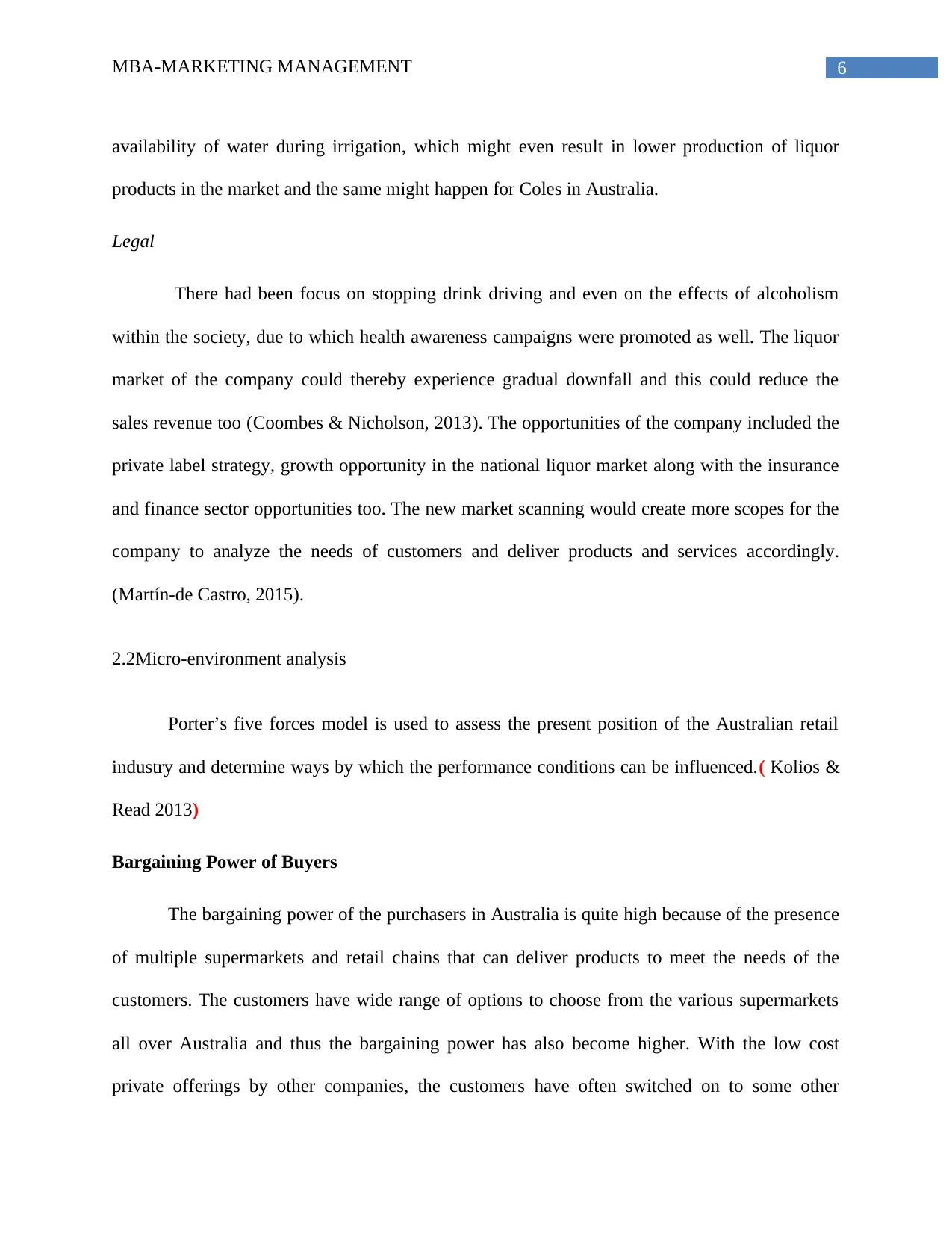
6MBA-MARKETING MANAGEMENT
availability of water during irrigation, which might even result in lower production of liquor
products in the market and the same might happen for Coles in Australia.
Legal
There had been focus on stopping drink driving and even on the effects of alcoholism
within the society, due to which health awareness campaigns were promoted as well. The liquor
market of the company could thereby experience gradual downfall and this could reduce the
sales revenue too (Coombes & Nicholson, 2013). The opportunities of the company included the
private label strategy, growth opportunity in the national liquor market along with the insurance
and finance sector opportunities too. The new market scanning would create more scopes for the
company to analyze the needs of customers and deliver products and services accordingly.
(Martín-de Castro, 2015).
2.2Micro‐environment analysis
Porter’s five forces model is used to assess the present position of the Australian retail
industry and determine ways by which the performance conditions can be influenced.( Kolios &
Read 2013)
Bargaining Power of Buyers
The bargaining power of the purchasers in Australia is quite high because of the presence
of multiple supermarkets and retail chains that can deliver products to meet the needs of the
customers. The customers have wide range of options to choose from the various supermarkets
all over Australia and thus the bargaining power has also become higher. With the low cost
private offerings by other companies, the customers have often switched on to some other
availability of water during irrigation, which might even result in lower production of liquor
products in the market and the same might happen for Coles in Australia.
Legal
There had been focus on stopping drink driving and even on the effects of alcoholism
within the society, due to which health awareness campaigns were promoted as well. The liquor
market of the company could thereby experience gradual downfall and this could reduce the
sales revenue too (Coombes & Nicholson, 2013). The opportunities of the company included the
private label strategy, growth opportunity in the national liquor market along with the insurance
and finance sector opportunities too. The new market scanning would create more scopes for the
company to analyze the needs of customers and deliver products and services accordingly.
(Martín-de Castro, 2015).
2.2Micro‐environment analysis
Porter’s five forces model is used to assess the present position of the Australian retail
industry and determine ways by which the performance conditions can be influenced.( Kolios &
Read 2013)
Bargaining Power of Buyers
The bargaining power of the purchasers in Australia is quite high because of the presence
of multiple supermarkets and retail chains that can deliver products to meet the needs of the
customers. The customers have wide range of options to choose from the various supermarkets
all over Australia and thus the bargaining power has also become higher. With the low cost
private offerings by other companies, the customers have often switched on to some other
Paraphrase This Document
Need a fresh take? Get an instant paraphrase of this document with our AI Paraphraser
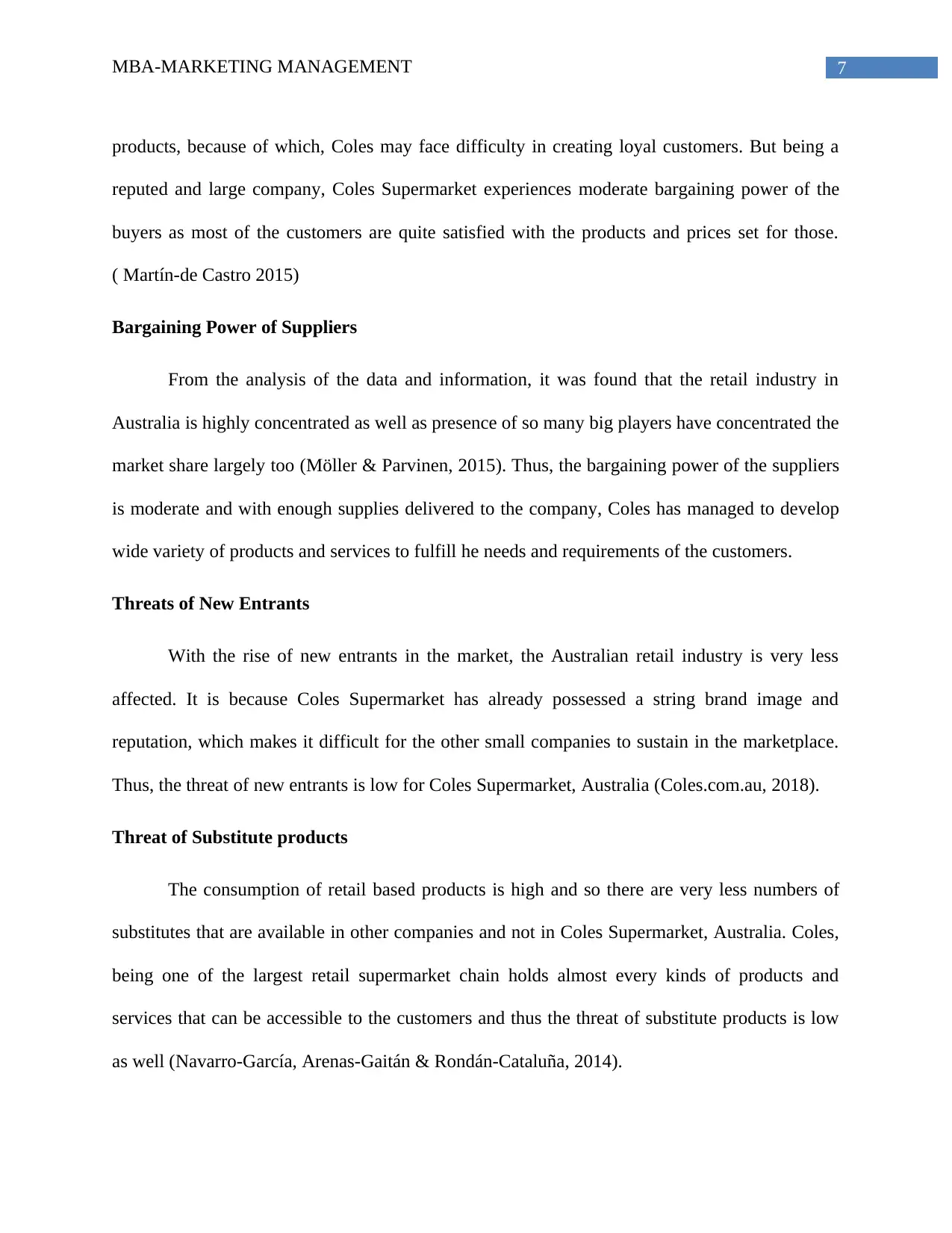
7MBA-MARKETING MANAGEMENT
products, because of which, Coles may face difficulty in creating loyal customers. But being a
reputed and large company, Coles Supermarket experiences moderate bargaining power of the
buyers as most of the customers are quite satisfied with the products and prices set for those.
( Martín-de Castro 2015)
Bargaining Power of Suppliers
From the analysis of the data and information, it was found that the retail industry in
Australia is highly concentrated as well as presence of so many big players have concentrated the
market share largely too (Möller & Parvinen, 2015). Thus, the bargaining power of the suppliers
is moderate and with enough supplies delivered to the company, Coles has managed to develop
wide variety of products and services to fulfill he needs and requirements of the customers.
Threats of New Entrants
With the rise of new entrants in the market, the Australian retail industry is very less
affected. It is because Coles Supermarket has already possessed a string brand image and
reputation, which makes it difficult for the other small companies to sustain in the marketplace.
Thus, the threat of new entrants is low for Coles Supermarket, Australia (Coles.com.au, 2018).
Threat of Substitute products
The consumption of retail based products is high and so there are very less numbers of
substitutes that are available in other companies and not in Coles Supermarket, Australia. Coles,
being one of the largest retail supermarket chain holds almost every kinds of products and
services that can be accessible to the customers and thus the threat of substitute products is low
as well (Navarro-García, Arenas-Gaitán & Rondán-Cataluña, 2014).
products, because of which, Coles may face difficulty in creating loyal customers. But being a
reputed and large company, Coles Supermarket experiences moderate bargaining power of the
buyers as most of the customers are quite satisfied with the products and prices set for those.
( Martín-de Castro 2015)
Bargaining Power of Suppliers
From the analysis of the data and information, it was found that the retail industry in
Australia is highly concentrated as well as presence of so many big players have concentrated the
market share largely too (Möller & Parvinen, 2015). Thus, the bargaining power of the suppliers
is moderate and with enough supplies delivered to the company, Coles has managed to develop
wide variety of products and services to fulfill he needs and requirements of the customers.
Threats of New Entrants
With the rise of new entrants in the market, the Australian retail industry is very less
affected. It is because Coles Supermarket has already possessed a string brand image and
reputation, which makes it difficult for the other small companies to sustain in the marketplace.
Thus, the threat of new entrants is low for Coles Supermarket, Australia (Coles.com.au, 2018).
Threat of Substitute products
The consumption of retail based products is high and so there are very less numbers of
substitutes that are available in other companies and not in Coles Supermarket, Australia. Coles,
being one of the largest retail supermarket chain holds almost every kinds of products and
services that can be accessible to the customers and thus the threat of substitute products is low
as well (Navarro-García, Arenas-Gaitán & Rondán-Cataluña, 2014).
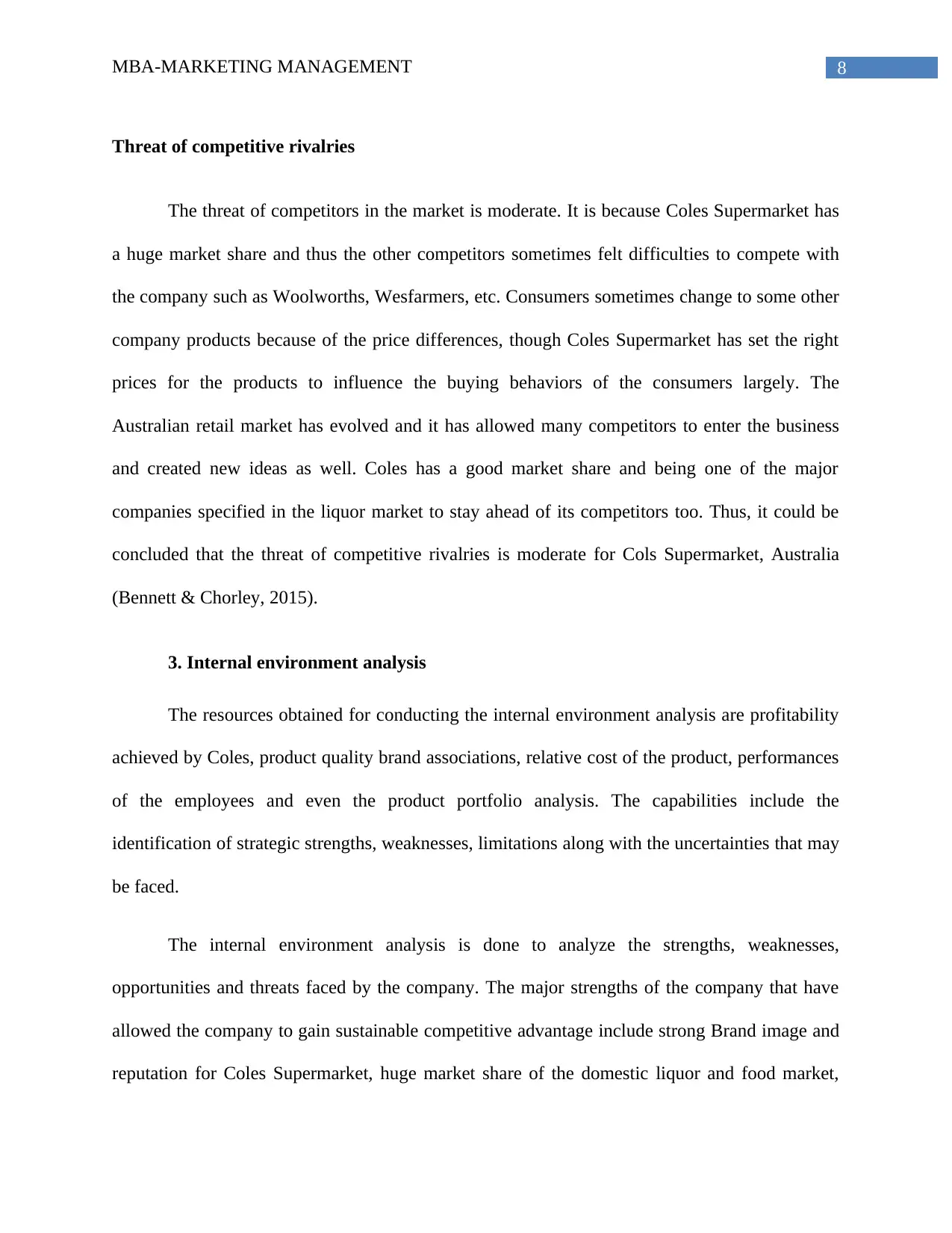
8MBA-MARKETING MANAGEMENT
Threat of competitive rivalries
The threat of competitors in the market is moderate. It is because Coles Supermarket has
a huge market share and thus the other competitors sometimes felt difficulties to compete with
the company such as Woolworths, Wesfarmers, etc. Consumers sometimes change to some other
company products because of the price differences, though Coles Supermarket has set the right
prices for the products to influence the buying behaviors of the consumers largely. The
Australian retail market has evolved and it has allowed many competitors to enter the business
and created new ideas as well. Coles has a good market share and being one of the major
companies specified in the liquor market to stay ahead of its competitors too. Thus, it could be
concluded that the threat of competitive rivalries is moderate for Cols Supermarket, Australia
(Bennett & Chorley, 2015).
3. Internal environment analysis
The resources obtained for conducting the internal environment analysis are profitability
achieved by Coles, product quality brand associations, relative cost of the product, performances
of the employees and even the product portfolio analysis. The capabilities include the
identification of strategic strengths, weaknesses, limitations along with the uncertainties that may
be faced.
The internal environment analysis is done to analyze the strengths, weaknesses,
opportunities and threats faced by the company. The major strengths of the company that have
allowed the company to gain sustainable competitive advantage include strong Brand image and
reputation for Coles Supermarket, huge market share of the domestic liquor and food market,
Threat of competitive rivalries
The threat of competitors in the market is moderate. It is because Coles Supermarket has
a huge market share and thus the other competitors sometimes felt difficulties to compete with
the company such as Woolworths, Wesfarmers, etc. Consumers sometimes change to some other
company products because of the price differences, though Coles Supermarket has set the right
prices for the products to influence the buying behaviors of the consumers largely. The
Australian retail market has evolved and it has allowed many competitors to enter the business
and created new ideas as well. Coles has a good market share and being one of the major
companies specified in the liquor market to stay ahead of its competitors too. Thus, it could be
concluded that the threat of competitive rivalries is moderate for Cols Supermarket, Australia
(Bennett & Chorley, 2015).
3. Internal environment analysis
The resources obtained for conducting the internal environment analysis are profitability
achieved by Coles, product quality brand associations, relative cost of the product, performances
of the employees and even the product portfolio analysis. The capabilities include the
identification of strategic strengths, weaknesses, limitations along with the uncertainties that may
be faced.
The internal environment analysis is done to analyze the strengths, weaknesses,
opportunities and threats faced by the company. The major strengths of the company that have
allowed the company to gain sustainable competitive advantage include strong Brand image and
reputation for Coles Supermarket, huge market share of the domestic liquor and food market,
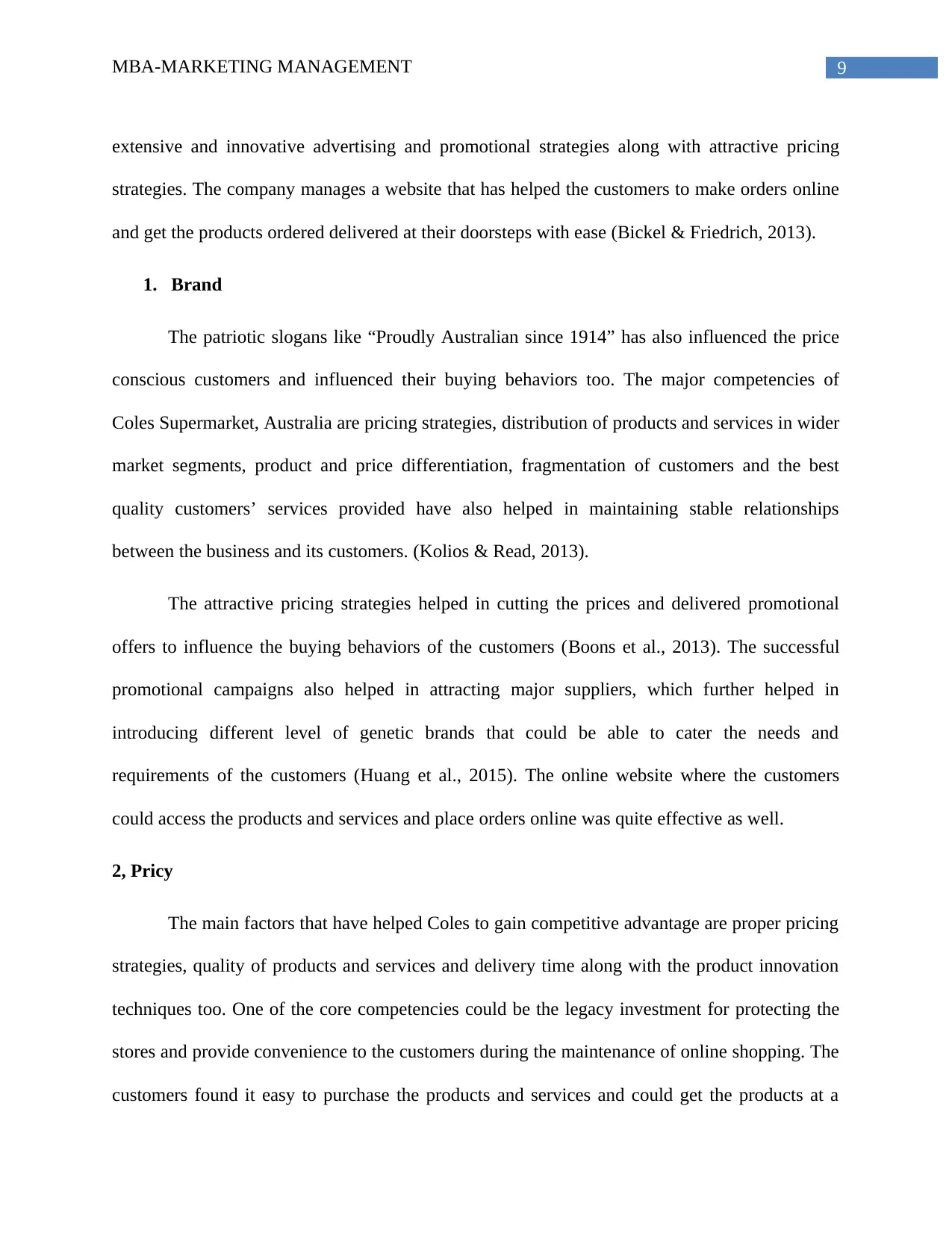
9MBA-MARKETING MANAGEMENT
extensive and innovative advertising and promotional strategies along with attractive pricing
strategies. The company manages a website that has helped the customers to make orders online
and get the products ordered delivered at their doorsteps with ease (Bickel & Friedrich, 2013).
1. Brand
The patriotic slogans like “Proudly Australian since 1914” has also influenced the price
conscious customers and influenced their buying behaviors too. The major competencies of
Coles Supermarket, Australia are pricing strategies, distribution of products and services in wider
market segments, product and price differentiation, fragmentation of customers and the best
quality customers’ services provided have also helped in maintaining stable relationships
between the business and its customers. (Kolios & Read, 2013).
The attractive pricing strategies helped in cutting the prices and delivered promotional
offers to influence the buying behaviors of the customers (Boons et al., 2013). The successful
promotional campaigns also helped in attracting major suppliers, which further helped in
introducing different level of genetic brands that could be able to cater the needs and
requirements of the customers (Huang et al., 2015). The online website where the customers
could access the products and services and place orders online was quite effective as well.
2, Pricy
The main factors that have helped Coles to gain competitive advantage are proper pricing
strategies, quality of products and services and delivery time along with the product innovation
techniques too. One of the core competencies could be the legacy investment for protecting the
stores and provide convenience to the customers during the maintenance of online shopping. The
customers found it easy to purchase the products and services and could get the products at a
extensive and innovative advertising and promotional strategies along with attractive pricing
strategies. The company manages a website that has helped the customers to make orders online
and get the products ordered delivered at their doorsteps with ease (Bickel & Friedrich, 2013).
1. Brand
The patriotic slogans like “Proudly Australian since 1914” has also influenced the price
conscious customers and influenced their buying behaviors too. The major competencies of
Coles Supermarket, Australia are pricing strategies, distribution of products and services in wider
market segments, product and price differentiation, fragmentation of customers and the best
quality customers’ services provided have also helped in maintaining stable relationships
between the business and its customers. (Kolios & Read, 2013).
The attractive pricing strategies helped in cutting the prices and delivered promotional
offers to influence the buying behaviors of the customers (Boons et al., 2013). The successful
promotional campaigns also helped in attracting major suppliers, which further helped in
introducing different level of genetic brands that could be able to cater the needs and
requirements of the customers (Huang et al., 2015). The online website where the customers
could access the products and services and place orders online was quite effective as well.
2, Pricy
The main factors that have helped Coles to gain competitive advantage are proper pricing
strategies, quality of products and services and delivery time along with the product innovation
techniques too. One of the core competencies could be the legacy investment for protecting the
stores and provide convenience to the customers during the maintenance of online shopping. The
customers found it easy to purchase the products and services and could get the products at a
Secure Best Marks with AI Grader
Need help grading? Try our AI Grader for instant feedback on your assignments.
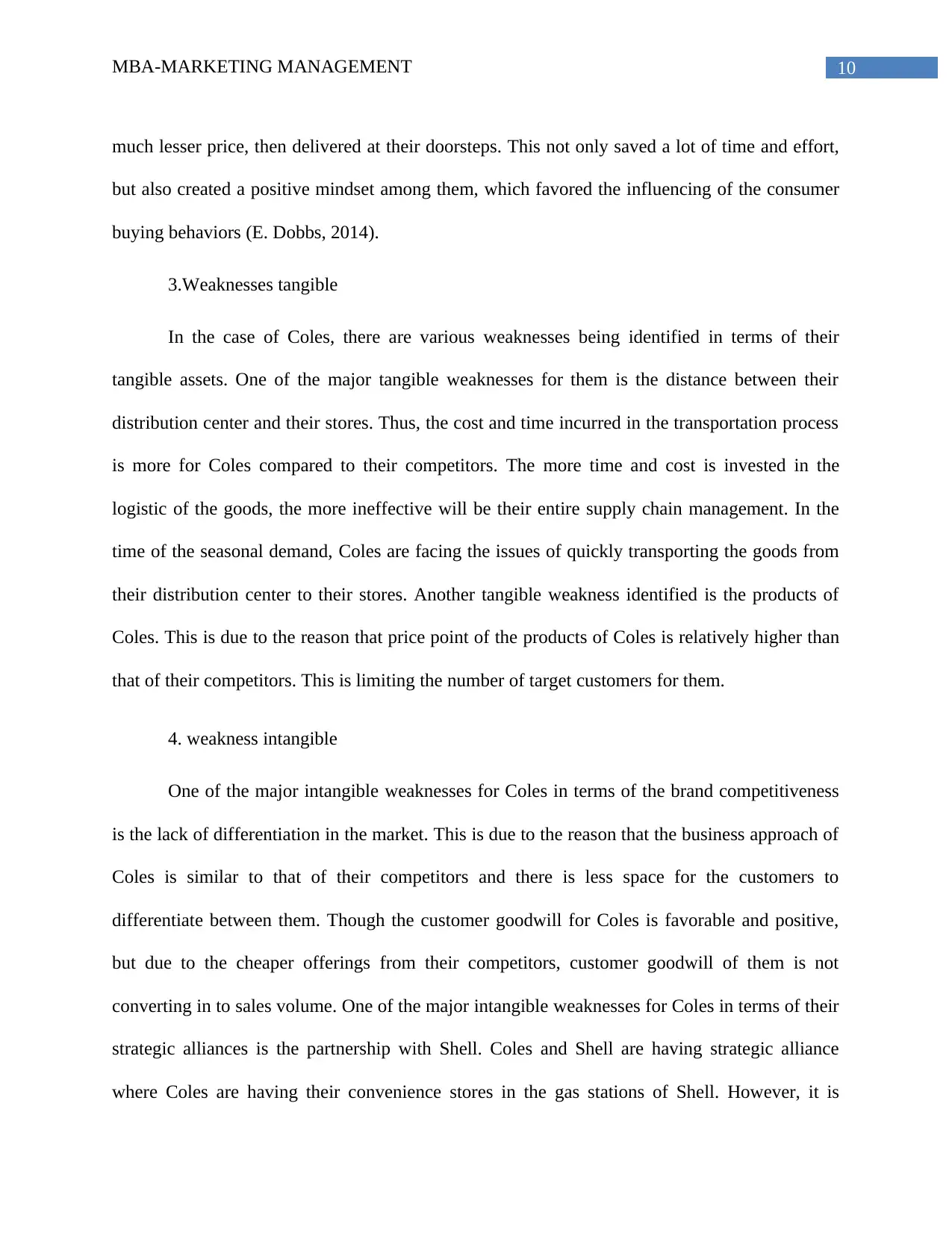
10MBA-MARKETING MANAGEMENT
much lesser price, then delivered at their doorsteps. This not only saved a lot of time and effort,
but also created a positive mindset among them, which favored the influencing of the consumer
buying behaviors (E. Dobbs, 2014).
3.Weaknesses tangible
In the case of Coles, there are various weaknesses being identified in terms of their
tangible assets. One of the major tangible weaknesses for them is the distance between their
distribution center and their stores. Thus, the cost and time incurred in the transportation process
is more for Coles compared to their competitors. The more time and cost is invested in the
logistic of the goods, the more ineffective will be their entire supply chain management. In the
time of the seasonal demand, Coles are facing the issues of quickly transporting the goods from
their distribution center to their stores. Another tangible weakness identified is the products of
Coles. This is due to the reason that price point of the products of Coles is relatively higher than
that of their competitors. This is limiting the number of target customers for them.
4. weakness intangible
One of the major intangible weaknesses for Coles in terms of the brand competitiveness
is the lack of differentiation in the market. This is due to the reason that the business approach of
Coles is similar to that of their competitors and there is less space for the customers to
differentiate between them. Though the customer goodwill for Coles is favorable and positive,
but due to the cheaper offerings from their competitors, customer goodwill of them is not
converting in to sales volume. One of the major intangible weaknesses for Coles in terms of their
strategic alliances is the partnership with Shell. Coles and Shell are having strategic alliance
where Coles are having their convenience stores in the gas stations of Shell. However, it is
much lesser price, then delivered at their doorsteps. This not only saved a lot of time and effort,
but also created a positive mindset among them, which favored the influencing of the consumer
buying behaviors (E. Dobbs, 2014).
3.Weaknesses tangible
In the case of Coles, there are various weaknesses being identified in terms of their
tangible assets. One of the major tangible weaknesses for them is the distance between their
distribution center and their stores. Thus, the cost and time incurred in the transportation process
is more for Coles compared to their competitors. The more time and cost is invested in the
logistic of the goods, the more ineffective will be their entire supply chain management. In the
time of the seasonal demand, Coles are facing the issues of quickly transporting the goods from
their distribution center to their stores. Another tangible weakness identified is the products of
Coles. This is due to the reason that price point of the products of Coles is relatively higher than
that of their competitors. This is limiting the number of target customers for them.
4. weakness intangible
One of the major intangible weaknesses for Coles in terms of the brand competitiveness
is the lack of differentiation in the market. This is due to the reason that the business approach of
Coles is similar to that of their competitors and there is less space for the customers to
differentiate between them. Though the customer goodwill for Coles is favorable and positive,
but due to the cheaper offerings from their competitors, customer goodwill of them is not
converting in to sales volume. One of the major intangible weaknesses for Coles in terms of their
strategic alliances is the partnership with Shell. Coles and Shell are having strategic alliance
where Coles are having their convenience stores in the gas stations of Shell. However, it is
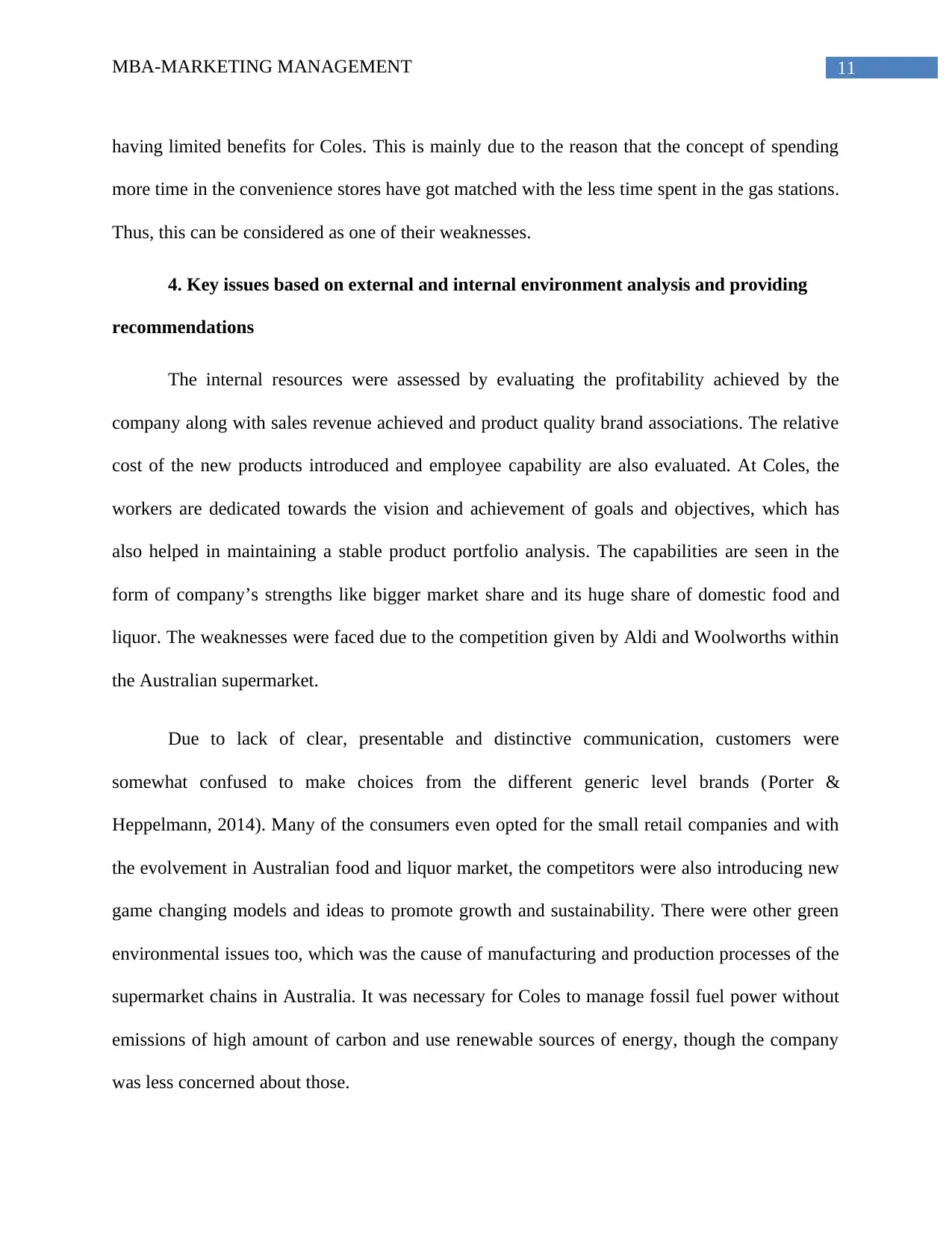
11MBA-MARKETING MANAGEMENT
having limited benefits for Coles. This is mainly due to the reason that the concept of spending
more time in the convenience stores have got matched with the less time spent in the gas stations.
Thus, this can be considered as one of their weaknesses.
4. Key issues based on external and internal environment analysis and providing
recommendations
The internal resources were assessed by evaluating the profitability achieved by the
company along with sales revenue achieved and product quality brand associations. The relative
cost of the new products introduced and employee capability are also evaluated. At Coles, the
workers are dedicated towards the vision and achievement of goals and objectives, which has
also helped in maintaining a stable product portfolio analysis. The capabilities are seen in the
form of company’s strengths like bigger market share and its huge share of domestic food and
liquor. The weaknesses were faced due to the competition given by Aldi and Woolworths within
the Australian supermarket.
Due to lack of clear, presentable and distinctive communication, customers were
somewhat confused to make choices from the different generic level brands (Porter &
Heppelmann, 2014). Many of the consumers even opted for the small retail companies and with
the evolvement in Australian food and liquor market, the competitors were also introducing new
game changing models and ideas to promote growth and sustainability. There were other green
environmental issues too, which was the cause of manufacturing and production processes of the
supermarket chains in Australia. It was necessary for Coles to manage fossil fuel power without
emissions of high amount of carbon and use renewable sources of energy, though the company
was less concerned about those.
having limited benefits for Coles. This is mainly due to the reason that the concept of spending
more time in the convenience stores have got matched with the less time spent in the gas stations.
Thus, this can be considered as one of their weaknesses.
4. Key issues based on external and internal environment analysis and providing
recommendations
The internal resources were assessed by evaluating the profitability achieved by the
company along with sales revenue achieved and product quality brand associations. The relative
cost of the new products introduced and employee capability are also evaluated. At Coles, the
workers are dedicated towards the vision and achievement of goals and objectives, which has
also helped in maintaining a stable product portfolio analysis. The capabilities are seen in the
form of company’s strengths like bigger market share and its huge share of domestic food and
liquor. The weaknesses were faced due to the competition given by Aldi and Woolworths within
the Australian supermarket.
Due to lack of clear, presentable and distinctive communication, customers were
somewhat confused to make choices from the different generic level brands (Porter &
Heppelmann, 2014). Many of the consumers even opted for the small retail companies and with
the evolvement in Australian food and liquor market, the competitors were also introducing new
game changing models and ideas to promote growth and sustainability. There were other green
environmental issues too, which was the cause of manufacturing and production processes of the
supermarket chains in Australia. It was necessary for Coles to manage fossil fuel power without
emissions of high amount of carbon and use renewable sources of energy, though the company
was less concerned about those.
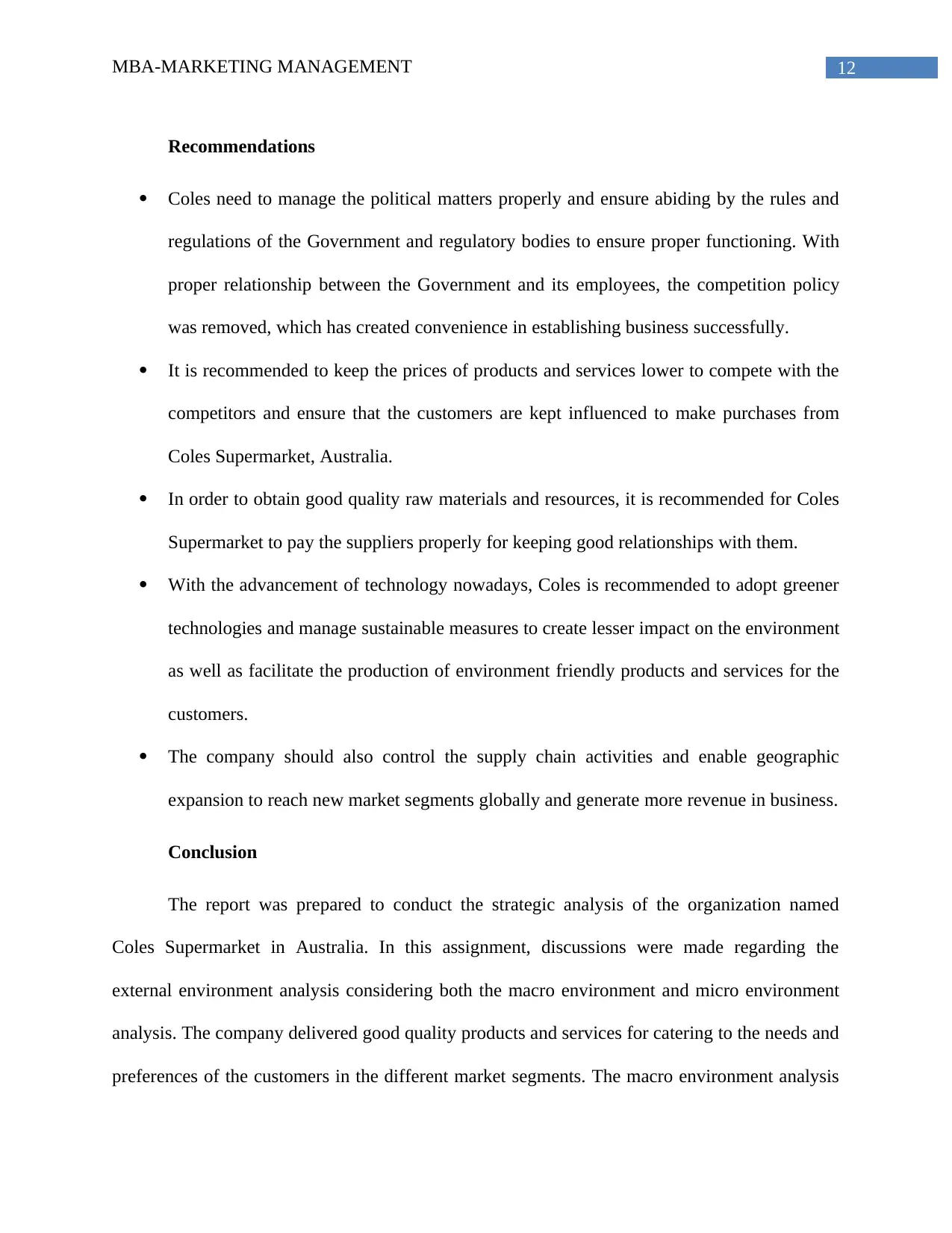
12MBA-MARKETING MANAGEMENT
Recommendations
Coles need to manage the political matters properly and ensure abiding by the rules and
regulations of the Government and regulatory bodies to ensure proper functioning. With
proper relationship between the Government and its employees, the competition policy
was removed, which has created convenience in establishing business successfully.
It is recommended to keep the prices of products and services lower to compete with the
competitors and ensure that the customers are kept influenced to make purchases from
Coles Supermarket, Australia.
In order to obtain good quality raw materials and resources, it is recommended for Coles
Supermarket to pay the suppliers properly for keeping good relationships with them.
With the advancement of technology nowadays, Coles is recommended to adopt greener
technologies and manage sustainable measures to create lesser impact on the environment
as well as facilitate the production of environment friendly products and services for the
customers.
The company should also control the supply chain activities and enable geographic
expansion to reach new market segments globally and generate more revenue in business.
Conclusion
The report was prepared to conduct the strategic analysis of the organization named
Coles Supermarket in Australia. In this assignment, discussions were made regarding the
external environment analysis considering both the macro environment and micro environment
analysis. The company delivered good quality products and services for catering to the needs and
preferences of the customers in the different market segments. The macro environment analysis
Recommendations
Coles need to manage the political matters properly and ensure abiding by the rules and
regulations of the Government and regulatory bodies to ensure proper functioning. With
proper relationship between the Government and its employees, the competition policy
was removed, which has created convenience in establishing business successfully.
It is recommended to keep the prices of products and services lower to compete with the
competitors and ensure that the customers are kept influenced to make purchases from
Coles Supermarket, Australia.
In order to obtain good quality raw materials and resources, it is recommended for Coles
Supermarket to pay the suppliers properly for keeping good relationships with them.
With the advancement of technology nowadays, Coles is recommended to adopt greener
technologies and manage sustainable measures to create lesser impact on the environment
as well as facilitate the production of environment friendly products and services for the
customers.
The company should also control the supply chain activities and enable geographic
expansion to reach new market segments globally and generate more revenue in business.
Conclusion
The report was prepared to conduct the strategic analysis of the organization named
Coles Supermarket in Australia. In this assignment, discussions were made regarding the
external environment analysis considering both the macro environment and micro environment
analysis. The company delivered good quality products and services for catering to the needs and
preferences of the customers in the different market segments. The macro environment analysis
Paraphrase This Document
Need a fresh take? Get an instant paraphrase of this document with our AI Paraphraser
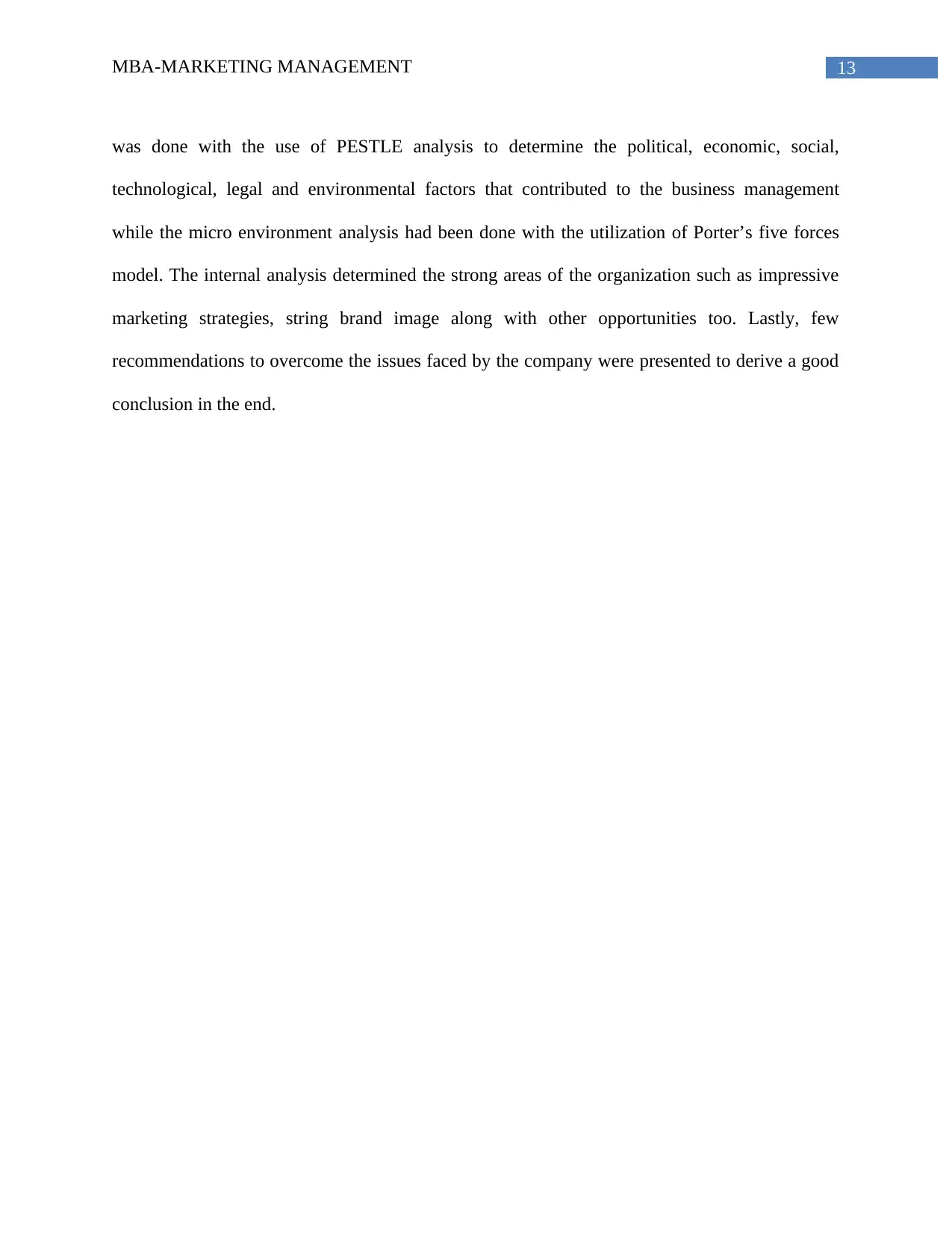
13MBA-MARKETING MANAGEMENT
was done with the use of PESTLE analysis to determine the political, economic, social,
technological, legal and environmental factors that contributed to the business management
while the micro environment analysis had been done with the utilization of Porter’s five forces
model. The internal analysis determined the strong areas of the organization such as impressive
marketing strategies, string brand image along with other opportunities too. Lastly, few
recommendations to overcome the issues faced by the company were presented to derive a good
conclusion in the end.
was done with the use of PESTLE analysis to determine the political, economic, social,
technological, legal and environmental factors that contributed to the business management
while the micro environment analysis had been done with the utilization of Porter’s five forces
model. The internal analysis determined the strong areas of the organization such as impressive
marketing strategies, string brand image along with other opportunities too. Lastly, few
recommendations to overcome the issues faced by the company were presented to derive a good
conclusion in the end.
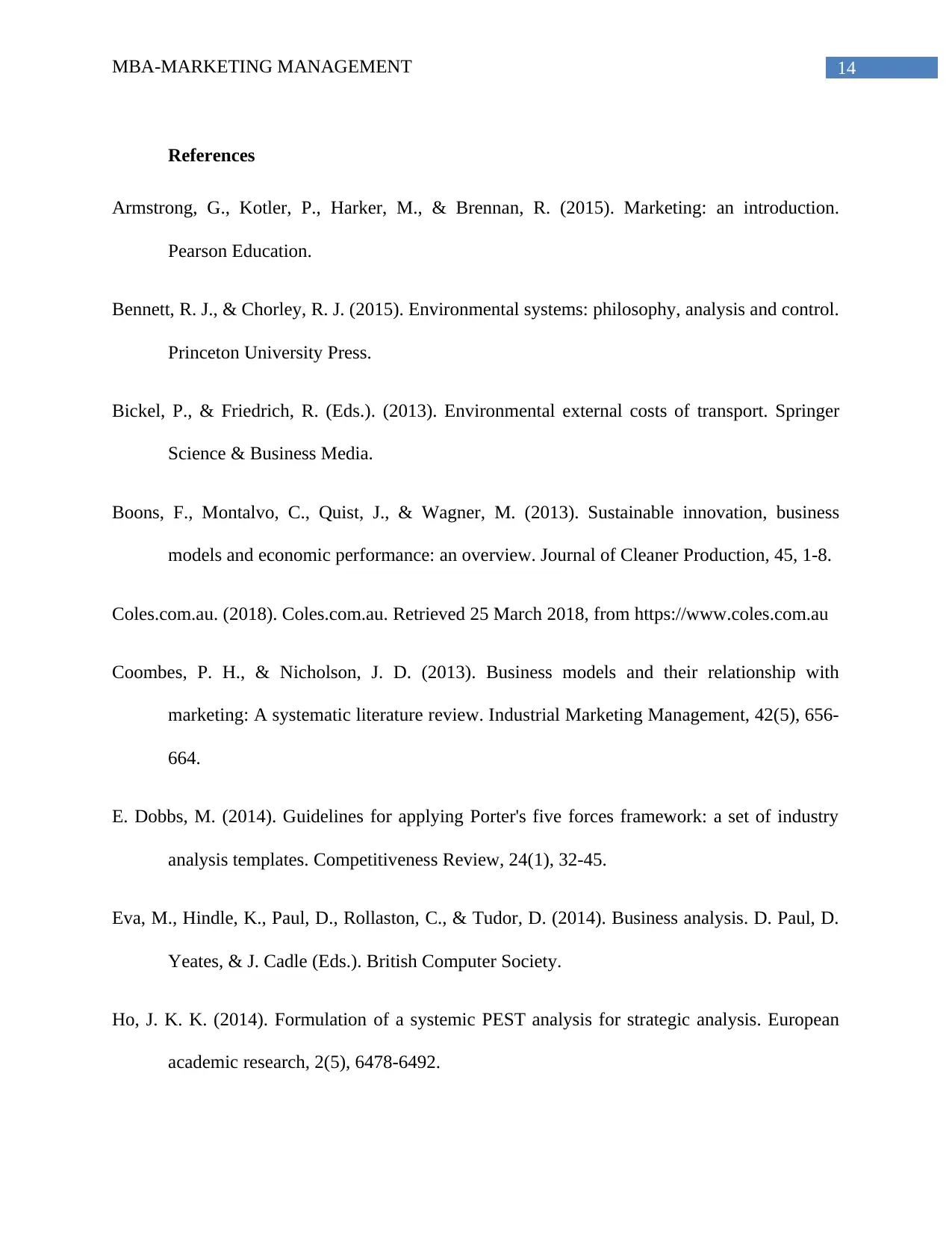
14MBA-MARKETING MANAGEMENT
References
Armstrong, G., Kotler, P., Harker, M., & Brennan, R. (2015). Marketing: an introduction.
Pearson Education.
Bennett, R. J., & Chorley, R. J. (2015). Environmental systems: philosophy, analysis and control.
Princeton University Press.
Bickel, P., & Friedrich, R. (Eds.). (2013). Environmental external costs of transport. Springer
Science & Business Media.
Boons, F., Montalvo, C., Quist, J., & Wagner, M. (2013). Sustainable innovation, business
models and economic performance: an overview. Journal of Cleaner Production, 45, 1-8.
Coles.com.au. (2018). Coles.com.au. Retrieved 25 March 2018, from https://www.coles.com.au
Coombes, P. H., & Nicholson, J. D. (2013). Business models and their relationship with
marketing: A systematic literature review. Industrial Marketing Management, 42(5), 656-
664.
E. Dobbs, M. (2014). Guidelines for applying Porter's five forces framework: a set of industry
analysis templates. Competitiveness Review, 24(1), 32-45.
Eva, M., Hindle, K., Paul, D., Rollaston, C., & Tudor, D. (2014). Business analysis. D. Paul, D.
Yeates, & J. Cadle (Eds.). British Computer Society.
Ho, J. K. K. (2014). Formulation of a systemic PEST analysis for strategic analysis. European
academic research, 2(5), 6478-6492.
References
Armstrong, G., Kotler, P., Harker, M., & Brennan, R. (2015). Marketing: an introduction.
Pearson Education.
Bennett, R. J., & Chorley, R. J. (2015). Environmental systems: philosophy, analysis and control.
Princeton University Press.
Bickel, P., & Friedrich, R. (Eds.). (2013). Environmental external costs of transport. Springer
Science & Business Media.
Boons, F., Montalvo, C., Quist, J., & Wagner, M. (2013). Sustainable innovation, business
models and economic performance: an overview. Journal of Cleaner Production, 45, 1-8.
Coles.com.au. (2018). Coles.com.au. Retrieved 25 March 2018, from https://www.coles.com.au
Coombes, P. H., & Nicholson, J. D. (2013). Business models and their relationship with
marketing: A systematic literature review. Industrial Marketing Management, 42(5), 656-
664.
E. Dobbs, M. (2014). Guidelines for applying Porter's five forces framework: a set of industry
analysis templates. Competitiveness Review, 24(1), 32-45.
Eva, M., Hindle, K., Paul, D., Rollaston, C., & Tudor, D. (2014). Business analysis. D. Paul, D.
Yeates, & J. Cadle (Eds.). British Computer Society.
Ho, J. K. K. (2014). Formulation of a systemic PEST analysis for strategic analysis. European
academic research, 2(5), 6478-6492.
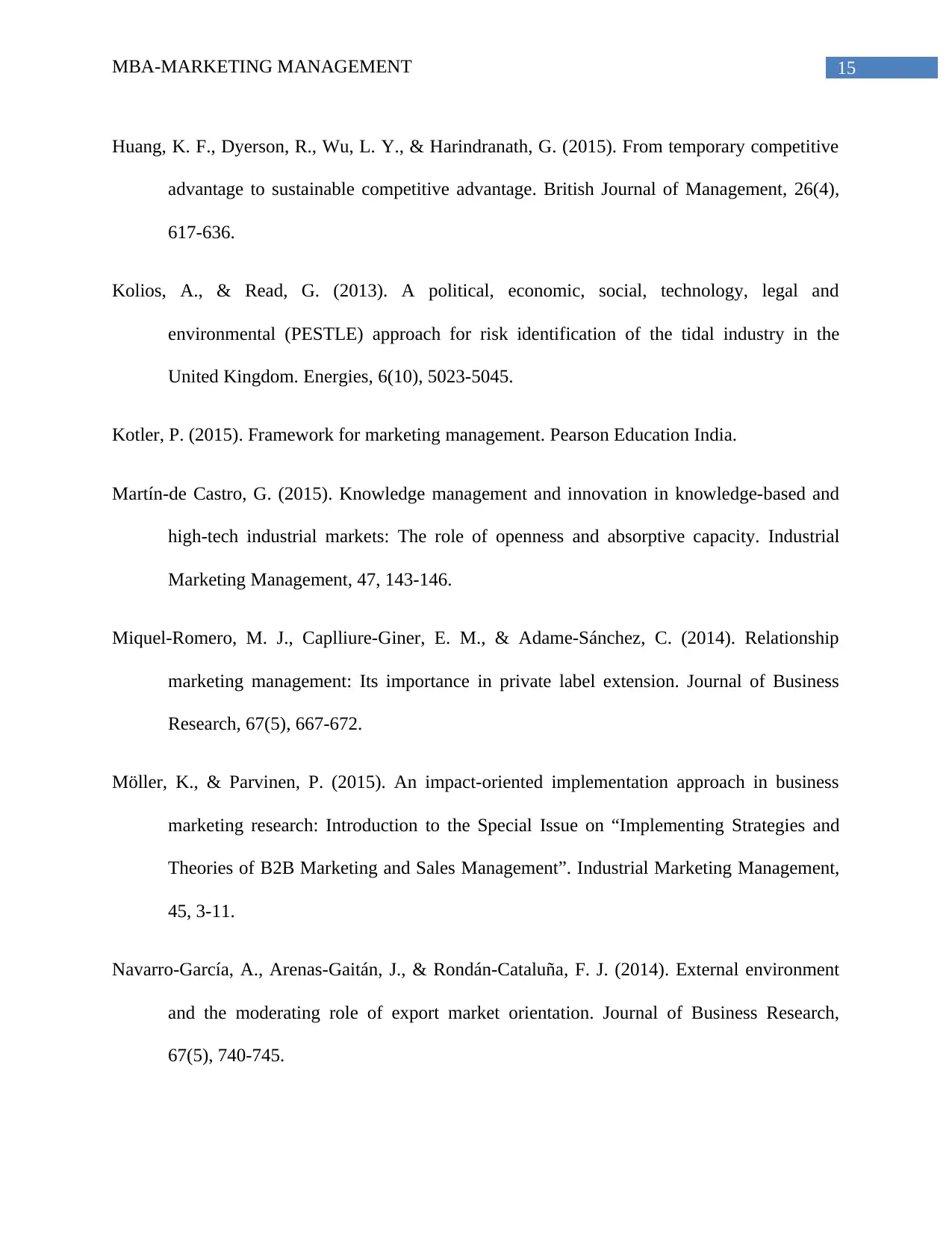
15MBA-MARKETING MANAGEMENT
Huang, K. F., Dyerson, R., Wu, L. Y., & Harindranath, G. (2015). From temporary competitive
advantage to sustainable competitive advantage. British Journal of Management, 26(4),
617-636.
Kolios, A., & Read, G. (2013). A political, economic, social, technology, legal and
environmental (PESTLE) approach for risk identification of the tidal industry in the
United Kingdom. Energies, 6(10), 5023-5045.
Kotler, P. (2015). Framework for marketing management. Pearson Education India.
Martín-de Castro, G. (2015). Knowledge management and innovation in knowledge-based and
high-tech industrial markets: The role of openness and absorptive capacity. Industrial
Marketing Management, 47, 143-146.
Miquel-Romero, M. J., Caplliure-Giner, E. M., & Adame-Sánchez, C. (2014). Relationship
marketing management: Its importance in private label extension. Journal of Business
Research, 67(5), 667-672.
Möller, K., & Parvinen, P. (2015). An impact-oriented implementation approach in business
marketing research: Introduction to the Special Issue on “Implementing Strategies and
Theories of B2B Marketing and Sales Management”. Industrial Marketing Management,
45, 3-11.
Navarro-García, A., Arenas-Gaitán, J., & Rondán-Cataluña, F. J. (2014). External environment
and the moderating role of export market orientation. Journal of Business Research,
67(5), 740-745.
Huang, K. F., Dyerson, R., Wu, L. Y., & Harindranath, G. (2015). From temporary competitive
advantage to sustainable competitive advantage. British Journal of Management, 26(4),
617-636.
Kolios, A., & Read, G. (2013). A political, economic, social, technology, legal and
environmental (PESTLE) approach for risk identification of the tidal industry in the
United Kingdom. Energies, 6(10), 5023-5045.
Kotler, P. (2015). Framework for marketing management. Pearson Education India.
Martín-de Castro, G. (2015). Knowledge management and innovation in knowledge-based and
high-tech industrial markets: The role of openness and absorptive capacity. Industrial
Marketing Management, 47, 143-146.
Miquel-Romero, M. J., Caplliure-Giner, E. M., & Adame-Sánchez, C. (2014). Relationship
marketing management: Its importance in private label extension. Journal of Business
Research, 67(5), 667-672.
Möller, K., & Parvinen, P. (2015). An impact-oriented implementation approach in business
marketing research: Introduction to the Special Issue on “Implementing Strategies and
Theories of B2B Marketing and Sales Management”. Industrial Marketing Management,
45, 3-11.
Navarro-García, A., Arenas-Gaitán, J., & Rondán-Cataluña, F. J. (2014). External environment
and the moderating role of export market orientation. Journal of Business Research,
67(5), 740-745.
Secure Best Marks with AI Grader
Need help grading? Try our AI Grader for instant feedback on your assignments.
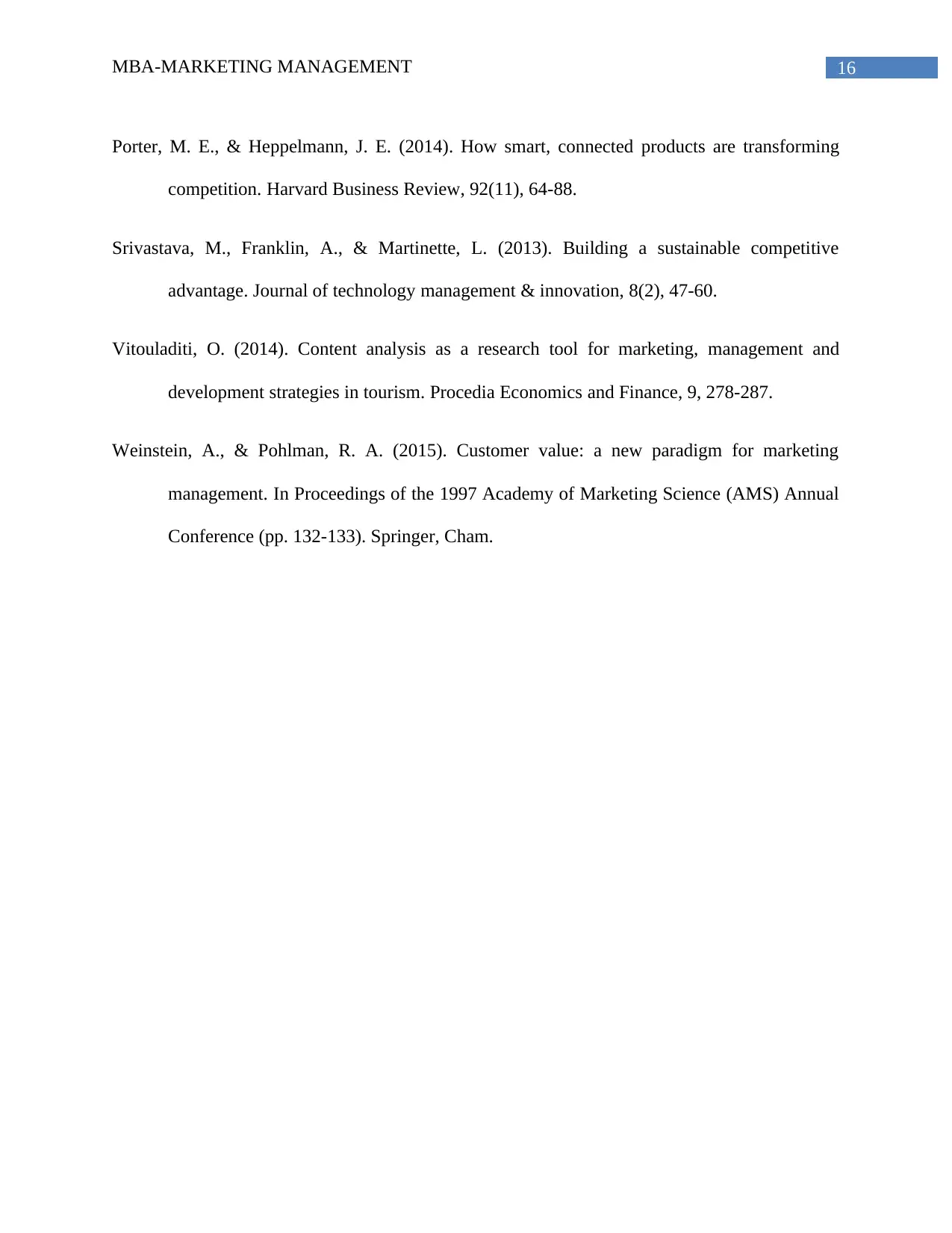
16MBA-MARKETING MANAGEMENT
Porter, M. E., & Heppelmann, J. E. (2014). How smart, connected products are transforming
competition. Harvard Business Review, 92(11), 64-88.
Srivastava, M., Franklin, A., & Martinette, L. (2013). Building a sustainable competitive
advantage. Journal of technology management & innovation, 8(2), 47-60.
Vitouladiti, O. (2014). Content analysis as a research tool for marketing, management and
development strategies in tourism. Procedia Economics and Finance, 9, 278-287.
Weinstein, A., & Pohlman, R. A. (2015). Customer value: a new paradigm for marketing
management. In Proceedings of the 1997 Academy of Marketing Science (AMS) Annual
Conference (pp. 132-133). Springer, Cham.
Porter, M. E., & Heppelmann, J. E. (2014). How smart, connected products are transforming
competition. Harvard Business Review, 92(11), 64-88.
Srivastava, M., Franklin, A., & Martinette, L. (2013). Building a sustainable competitive
advantage. Journal of technology management & innovation, 8(2), 47-60.
Vitouladiti, O. (2014). Content analysis as a research tool for marketing, management and
development strategies in tourism. Procedia Economics and Finance, 9, 278-287.
Weinstein, A., & Pohlman, R. A. (2015). Customer value: a new paradigm for marketing
management. In Proceedings of the 1997 Academy of Marketing Science (AMS) Annual
Conference (pp. 132-133). Springer, Cham.
1 out of 17
Related Documents
Your All-in-One AI-Powered Toolkit for Academic Success.
+13062052269
info@desklib.com
Available 24*7 on WhatsApp / Email
![[object Object]](/_next/static/media/star-bottom.7253800d.svg)
Unlock your academic potential
© 2024 | Zucol Services PVT LTD | All rights reserved.



